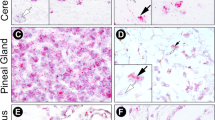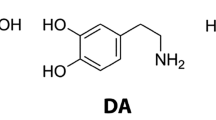Abstract
BIOGENIC amines are mostly found in bound form in tissues, but little is known regarding the chemical nature of the bonds involved in the attachment of biogenic amines or their derivatives to macromolecules. We have studied certain aspects of the firm attachment of indoleamines or their derivatives to acid insoluble material (lipoproteins ?) obtained from the central nervous system. In those in vitro studies it was demonstrated that a large part of this incorporation occurs after conversion of the indoleamines to their corresponding aldehydes and can be prevented by the presence of pargyline (a monoamine oxidase inhibitor) in the medium1,2. A similar type of incorporation of radioactivity into acid insoluble material was also observed after in vivo endocranial administration of labelled serotonin into mice3. Within a range of dosages (25 to 250 nmoles/g wet brain) this in vivo incorporation diminishes by pretreatment of the animal with monoamine oxidase inhibitors (MAOI)4. In the same dosage range 5-hydroxy-indole-3-acetaldehyde produces in rabbits characteristic changes of photic evoked responses of the optic cortex when injected intraventricularly5. When administered intraperitoneally at relatively higher dosages into newly hatched male chicks this aldehyde, like serotonin, induces eyelid closure and a depression in posture resembling true sleep5. At much lower dosages (5–10 nmoles/g brain), however, the effectiveness of MAOI pretreatment in preventing the in vivo incorporation of exogenously administered labelled serotonin rapidly diminishes. This is probably because at such small dosages the amount of exogenous amine which eventually enters the cells may be accommodated within the storage apparatus of the cells before it has the chance to be attacked by (mitochondrial) monoamine oxidase.
This is a preview of subscription content, access via your institution
Access options
Subscribe to this journal
Receive 51 print issues and online access
$199.00 per year
only $3.90 per issue
Buy this article
- Purchase on Springer Link
- Instant access to full article PDF
Prices may be subject to local taxes which are calculated during checkout
Similar content being viewed by others
References
Alivisatos, S. G. A., Ungar, F., and Parmar, S. S., Biochem. Biophys. Res. Commun., 25, 495 (1966).
Alivisatos, S. G. A., and Ungar, F., Biochemistry, 7, 285 (1968).
Alivisatos, S. G. A., Ungar, F., Parmar, S. S., and Seth, P. K., Biochem. Pharmacol., 17, 1993 (1968).
Alivisatos, S. G. A., Ungar, F., Seth, P. K., and Levitt, L. P., Biochem. Pharmacol. (in the press).
Sabelli, H. C., Giardina, W. J., Alivisatos, S. G. A., Seth, P. K., and Ungar, F., Nature, 223, 73 (1969).
Alivisatos, S. G. A., Papaphilis, A. D., Seth, P. K., and Ungar, F., Pharmacologist, 11, 262, Abstr. No. 179 (1969).
Lowry, O. H., Rosebrough, N. J., Farr, A. L., and Randall, R. J., J. Biol. Chem., 193, 265 (1951).
Whittaker, V. P., Michaelson, I. A., and Kirkland, R. J. A., Biochem. J., 90, 293 (1964).
Whittaker, V. P., and Sheridan, M. N., J. Neurochem., 12, 363 (1965).
De Robertis, E., Science, 156, 907 (1967).
Pant, M. C., Parmar, S. S., and Bhargava, K. P., Canad. J. Biochem., 42, 1114 (1964).
Biogenic Amines and Central Nervous System, Proc. Fourth Intern. Cong. Pharmacol. (Basel) (edit. by Alivisatos, S. G. A.), 1 (in the press).
Hökfelt, T., Z. Zellforsch., 91, 1 (1968).
Riley, W. D., and Snell, E. E., Biochemistry, 7, 3520 (1968).
Hodgins, D., and Abeles, R. H., J. Biol. Chem., 242, 5158 (1967).
Author information
Authors and Affiliations
Rights and permissions
About this article
Cite this article
ALIVISATOS, S., PAPAPHILIS, A., UNGAR, F. et al. Chemical Nature of Binding of Serotonin in the Central Nervous System. Nature 226, 455–456 (1970). https://doi.org/10.1038/226455a0
Received:
Issue Date:
DOI: https://doi.org/10.1038/226455a0
This article is cited by
-
Mechanism of Insecticide-induced Diuresis in Rhodnius
Nature (1971)
Comments
By submitting a comment you agree to abide by our Terms and Community Guidelines. If you find something abusive or that does not comply with our terms or guidelines please flag it as inappropriate.



